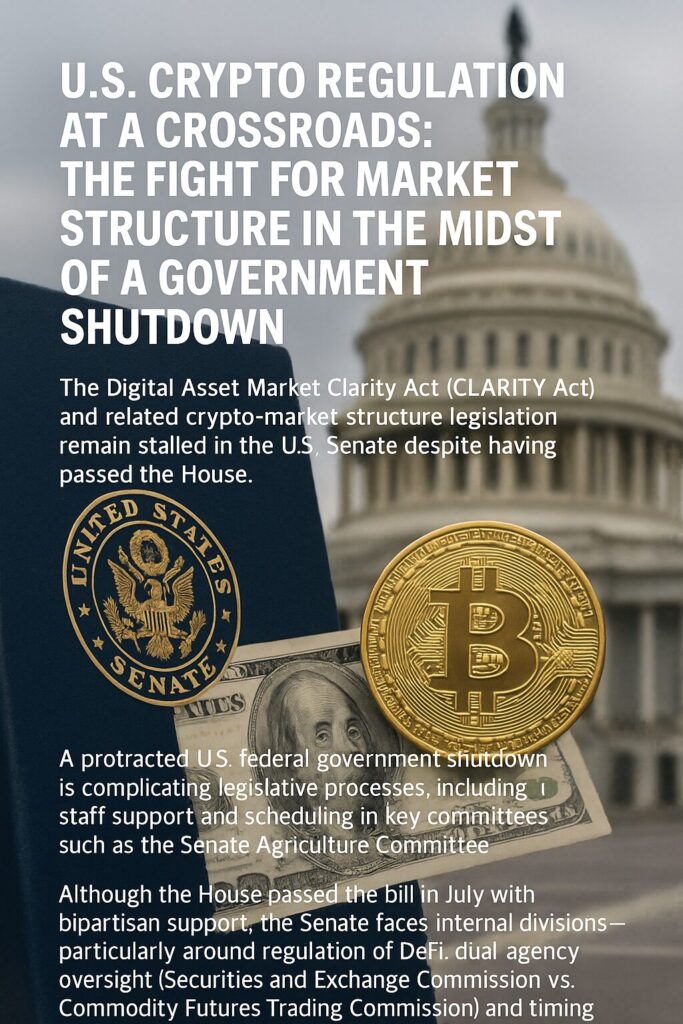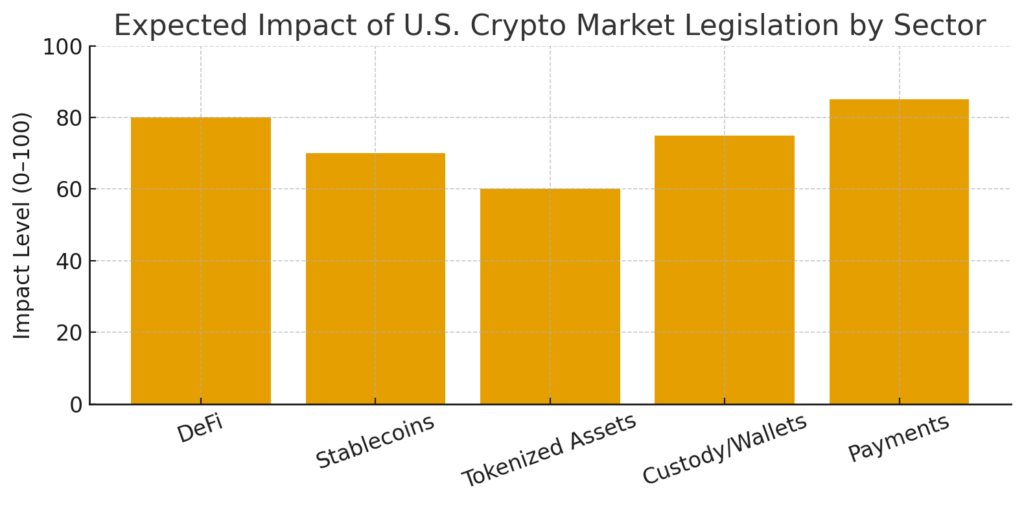
Key Points :
- The Digital Asset Market Clarity Act (CLARITY Act) and related crypto-market-structure legislation remain stalled in the U.S. Senate despite having passed the House.
- A protracted U.S. federal government shutdown is complicating legislative processes, including staff support and scheduling in key committees such as the Senate Agriculture Committee.
- Although the House passed the bill in July with bipartisan support, the Senate faces internal divisions—particularly around regulation of DeFi, dual-agency oversight (Securities and Exchange Commission vs. Commodity Futures Trading Commission) and timing before the 2026 midterm elections.
- From an industry perspective, regulatory clarity is vital: firms working on DeFi protocols, token issuances, stablecoins, and ancillary services all stand to benefit or be disadvantaged depending on the eventual legislation.
- For investors and blockchain-practitioners, delays in legislation mean continued uncertainty around token classification, platform-licensing, custody regime, and compliance burdens—yet also opportunities to engage early before rules solidify.
1. Background: What’s Behind the Bill?
The U.S. Congress has in recent years attempted to catch up with rapid crypto-market innovation. The CLARITY Act (also known as the “Digital Asset Market Clarity Act of 2025”) is one of the key legislative vehicles designed to provide a framework for digital commodity and security classification, intermediary registration, and oversight across agencies.
Key elements of the bill include:
- Definitions of “digital commodity,” “digital asset,” “decentralised finance trading protocol” and similar terms, aiming to clarify when an asset is overseen by the SEC vs. the CFTC.
- Expedited registration for digital commodity exchanges, brokers and dealers (under the CFTC framework) to bring spot markets into clearer regulatory boundaries.
- Exemption or adjustment of state securities laws with respect to digital commodities to reduce fragmented regulatory burdens.
- Mandated joint rule-making between SEC and CFTC for mixed digital-asset transactions to reduce duplicative regulation.
- Studies and reports on DeFi, tokenised securities, custodial arrangements, blockchain payment infrastructure, illicit behaviour in digital assets—showing the bill is not just about markets but the broader blockchain ecosystem.
For practitioners in token issuance, wallets, DeFi protocols or tokenized securities, this bill signals potentially major changes in how tokens are classified, how platforms get licensed, and how compliance is managed.

2. Current Status: Deadlock Amid Shutdown
Government Shutdown Impact
The U.S. government is experiencing one of its longest shutdowns in history. In this context:
- The United States Senate discussions around the bill remain active but complicated: Republican Senator John Boozman (member of the Senate Agriculture Committee) is reported to meet with White House crypto/AI czar David Sacks and Democratic Senator Cory Booker to work through the draft.
- However, staff levels for technical input (especially on DeFi, blockchain infrastructure) are reduced or offline due to furloughs—limiting expert briefing capacity. Boozman’s comment that staff-level work is ongoing daily reflects this.
- The scheduling of committee votes and full-Senate debates remains uncertain because many legislators prioritise funding bills to reopen the government rather than crypto regulation per se. It’s unclear whether the crypto bill will be prioritised.
Timing and Political Pressures
- The House passed the bill in July 2025 by a vote of 294–137 with bipartisan support.
- Senators such as Tom Tillis (Republican) have publicly emphasised the need to pass crypto-market legislation in the window before the 2026 midterms (stating target for January–February).
- On the other hand, additional draft bills (e.g., the Responsible Financial Innovation Act—RFIA) are being floated by other committees (Senate Banking Committee) which diverge from the House’s CLARITY framework, meaning internal alignment remains weak.
In sum: the legislation remains alive, but subject to competing drafts, committee jurisdictional friction, and a federal shutdown that complicates process.

3. Implications for the Crypto/Blockchain Ecosystem
For Token Issuers & DeFi Projects
- The classification regime (security vs commodity vs “digital commodity” etc) will determine if a token must register with the SEC (more stringent) or operate under CFTC oversight (broader). For DeFi protocols, clarity here is crucial.
- Expedited registration processes for exchanges/brokers may open opportunities for spot trading platforms and token launch services—but they will also heighten compliance expectations (KYC/AML, reporting).
- If the final law mandates clearer rules around DeFi messaging/trading systems (as the bill text suggests), protocols that currently operate in ambiguous jurisdictions may need to adjust or relocate.
For Wallets, Payment & Custody Services
- The inclusion of provisions for “mature blockchain system” requirements and record-keeping via blockchain means that wallet providers and custody services must anticipate more robust rules.
- The bill’s focus on payment blockchain infrastructure (study obligations) signals that blockchain payment use-cases (remittances, stablecoin payments, enterprise settlement) may gain regulatory acceptance. This is positive for non-custodial wallet infrastructure and crypto-enabled payments.
For Investors & Income-Seeking Participants
- Regulatory clarity tends to reduce risk premia: if tokens are clearly classified and intermediaries are properly registered, institutional capital may flow more freely. That means new asset-issuance opportunities and secondary-market liquidity.
- On the flip side, delay or uncertainty means token-issuers may posture but wait; investors should remain cautious, as regulatory enforcement risk remains elevated.
- For stablecoins and programmable payments, the broader regulatory framework (including separate stablecoin legislation) reinforces that payments-use cases are being taken seriously—this may support assets oriented to payments/settlements rather than pure speculation.

4. Recent Developments & What’s New
- Security experts have sent letters to Senate leadership warning that the pending crypto-market legislation may contain serious national-security and AML risks—especially with respect to DeFi platforms and cross-border flows.
- The labor federation AFL‑CIO has opposed the RFIA draft, citing concerns that the bill provides only superficial regulation and could expose retirement funds to crypto-volatility.
- Meanwhile, the U.S. Senate earlier passed the stablecoin-specific GENIUS Act in June 2025, a milestone in crypto regulation and demonstrating bipartisan appetite for oversight.
- The industry commentary now views the CLARITY Act not just as a token-classification bill but as the keystone for the next phase of crypto’s institutional integration in the United States. Legal firms note that even if the current draft changes significantly, the momentum is irreversible.
These developments matter for readers looking for new assets and real-world blockchain applications: legislation of this kind tends to shift the opportunity frontier from speculative tokens toward utility tokens, regulated platforms, payment rails, enterprise use-cases and tokenised finance.
5. What This Means for the “Next Wave” of Crypto Use-Cases
Payments & Tokenised Infrastructure
With regulation acknowledging payment-oriented digital assets and blockchain payment infrastructure in mandatory studies, projects oriented around stablecoins, tokenised fiat, remittances, cross-border settlement have a relative advantage. Wallets supporting non-custodial, compliant flows may gain traction.
Tokenisation of Real-World Assets
The bill’s references to tokenised securities and derivatives pathways suggest a future where blockchain-native asset-classes (tokenised equities, tokenised real estate, tokenised commodities) gain clearer regulatory pathways. Early mover projects may benefit from pre-regulation positioning.
DeFi & Interoperability Platforms
Although the bill does place DeFi under scrutiny, the mere fact that it mandates studies on DeFi protocols, messaging/trading systems and interoperable chains means that protocol teams can anticipate regulatory frameworks rather than operate entirely in the dark. Those that build with transparency and compliance-ready design posture may gain trust.
Compliance and Non-Custodial UX
As frameworks mature, the user-experience becomes differentiator: non-custodial wallets, swap aggregators, cross-chain bridges that can provide audit trails, user disclosure, risk-education (as mandated) will be better positioned for enterprise adoption. For practitioners building wallets (such as your “dzilla Wallet”), scheduling these features early may provide competitive advantage.
6. Risks & Caveats to Watch
- Despite broader momentum, passage is not guaranteed in the near term—committee deadlock, prioritisation of government-funding bills and competing drafts mean key provisions could change significantly.
- Over-regulation or mis-classification may stifle innovation: some crypto industry observers fear burdensome regimes may push innovation offshore.
- National-security/AML concerns may produce last-minute amendments that affect DeFi, cross-border flows, custodial-liability regimes, which could increase cost of compliance.
- Time-to-market matters: for token issuers and platform developers, the regulatory window is shifting. Waiting too long may mean entering under a harder regime; moving too early may expose to enforcement risk.
Conclusion
For investors, builders and blockchain-practitioners seeking the “next wave” of crypto assets and practical blockchain use-cases, the unfolding regulatory environment in the U.S. matters deeply. The CLARITY Act and its sibling bills represent one of the most significant legislative efforts to date to bring structure to digital-asset markets: the asset taxonomy, intermediary registration frameworks, cross-agency rule-making, DeFi and payment-chain oversight—all of these touch the full spectrum of crypto protocols, tokens and infrastructure.
While the current government shutdown has slowed progress and introduced uncertainty, the underlying momentum remains strong: the House has passed the bill, stablecoin legislation is already enshrined, and industry actors are positioning accordingly. The key takeaway for readers: regulatory clarity tends to favour projects and tokens that align early with compliance and real-world utility—not purely speculative plays. If you are seeking new tokens, income-streams or blockchain applications beyond “buy-and-hold”, now is a strategic moment to assess projects capable of thriving under a clearer regulatory framework.

